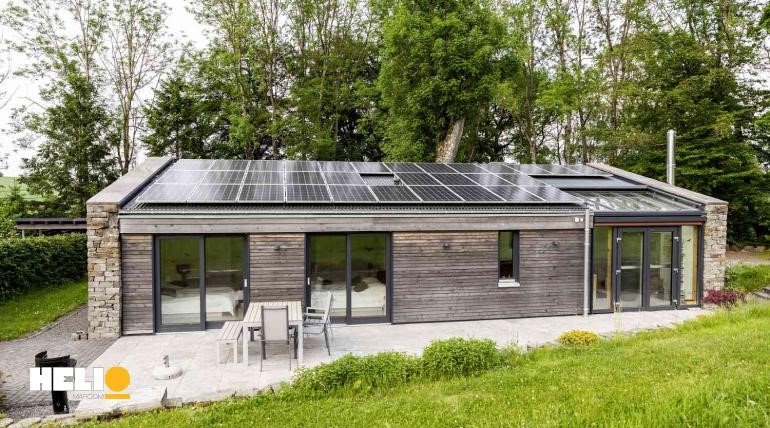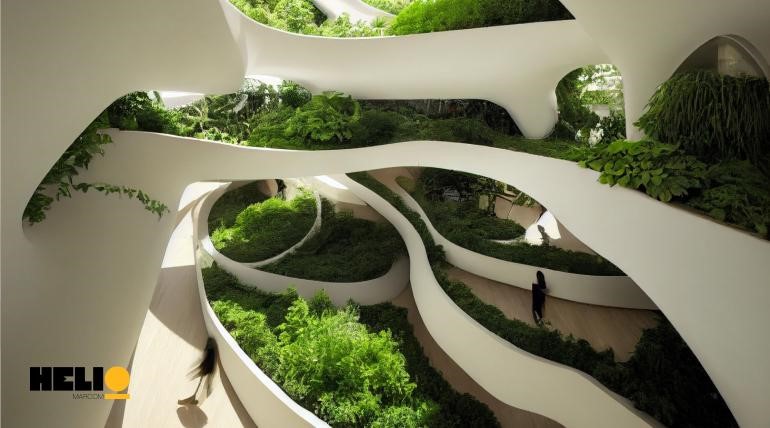Sustainable architecture has transitioned from a niche interest to a mainstream approach, emphasizing resource efficiency and reduced environmental impact. This guide explores the significance, principles, and innovative applications of sustainable architecture that are reshaping residential and commercial spaces globally.
In a world where sustainable architecture is essential, companies like Helio Archi are leading the way. Helio Archi’s focus on eco-conscious design highlights that functionality and aesthetics need not be sacrificed for sustainability.
What Is Sustainable Architecture?
Sustainable architecture goes beyond simple energy conservation. It embraces a holistic approach that includes resource lifecycle, occupant well-being, and environmental preservation. By addressing issues like climate change, resource depletion, and habitat destruction, sustainable architecture promotes long-term viability, making it an indispensable practice for the future of construction.
If you need the help of a top architecture firm in dubai, join Helio Archi right away.
Key Characteristics of Sustainable Architecture
Energy Efficiency: Sustainable buildings incorporate passive design strategies, like optimal orientation for natural lighting, high-performance insulation, and efficient ventilation systems. Solar panels and geothermal heat pumps further reduce reliance on nonrenewable energy sources.
Use of Renewable and Recycled Materials: Sustainable architecture prioritizes materials with low environmental impact, like sustainably harvested wood and recycled metals. Local sourcing also minimizes transportation emissions.
Water Conservation: Rainwater harvesting, greywater recycling, and low-flow fixtures are essential components, alongside landscaping with drought-resistant plants to reduce water needs.
Indoor Environmental Quality (IEQ): Sustainable design improves indoor air quality by incorporating ample natural light, proper ventilation, and low-VOC materials, fostering a healthier living environment.
Site Optimization: Thoughtful site selection and design consider existing topography, natural winds, and sunlight to integrate buildings seamlessly with their surroundings.
Holistic Lifecycle Approach: Sustainable design considers the long-term lifecycle, incorporating adaptability and future deconstruction planning for resource reuse.
Read More: what are current trends in architecture
Why Sustainable Architecture Matters Today
Sustainable architecture offers a wide range of environmental, economic, and social benefits:
- Climate Change Mitigation: By reducing greenhouse gas emissions through energy efficiency and low-carbon materials, sustainable architecture directly addresses climate change.
- Resource Conservation: Sustainable buildings use recycled and renewable materials, reducing waste and pressure on natural resources.
- Economic Benefits: Though initial costs can be higher, sustainable buildings save on energy and water bills, increase property values, and require less maintenance over time.
- Health and Well-being: Sustainable architecture enhances indoor environmental quality, benefiting occupants’ physical and mental health through better air quality and biophilic design.
- Social Equity: Sustainable housing initiatives and local economic stimulation through green jobs contribute to a more equitable society.
Read More: contemporary architectural style
Innovative Examples of Sustainable Architecture
From residential to commercial spaces, here are notable examples of sustainable architecture:
- Bosco Verticale (Milan, Italy): Known as the “Vertical Forest,” these towers are covered in lush greenery, promoting biodiversity and improving air quality.
- The Edge (Amsterdam, Netherlands): One of the most sustainable office buildings, with energy-efficient design, solar panels, and smart technology.
- The Crystal (London, UK): This building uses solar and ground-source heat pumps, aiming for zero carbon emissions.
- The Bullitt Center (Seattle, USA): Designed to be self-sufficient in energy and water, featuring solar panels, rainwater harvesting, and composting systems.

Sustainable Residential Architecture: Transforming Homes
Residential architecture increasingly emphasizes sustainability through energy-efficient designs and eco-friendly materials. Leading architects, such as Mario Cucinella and Ingenhoven Architects, demonstrate how homes can reduce their environmental impact while enhancing comfort.
Tips for Sustainable Home Construction:
- Use passive design techniques to maximize natural light and ventilation.
- Select recycled, renewable, and locally sourced materials.
- Integrate renewable energy sources like solar panels.
- Incorporate water-saving features like rainwater harvesting systems.
If you want to transform your residential space style in Dubai, you definitely need best architecture firms dubai like Helio Archi.
The Future of Sustainable Architecture
The field of sustainable architecture continues to evolve, incorporating new technologies and design philosophies:
- Biomimicry: Inspired by nature, architects are developing buildings that emulate natural systems, like termite mounds for temperature regulation or lotus leaves for water resistance.
- Modular and Prefabricated Construction: This approach reduces waste, shortens construction times, and enhances efficiency.
- Smart Building Technologies: IoT sensors and AI will make buildings more responsive, automatically adjusting lighting and temperature to optimize energy use.
- Regenerative Design: Beyond sustainability, regenerative architecture aims for a positive environmental impact, producing more energy and water than needed.
How You Can Support Sustainable Architecture
Whether you’re an architect, builder, homeowner, or business leader, there are ways to contribute to a sustainable future:
- Advocate for green building policies in your community.
- Incorporate sustainability in your home or business projects.
- Educate yourself and others on the principles of sustainable design.
Partner with Helio Archi for a Sustainable Future
For those seeking innovative sustainable architecture, Helio Archi offers expertise in designing eco-conscious buildings that meet and exceed sustainability standards. From residential projects to commercial developments, Helio Archi is committed to creating spaces that honor the planet and enhance well-being.
Contact Helio Archi today if you need an advertising agency dubai to discuss how we can collaborate on your upcoming project, making it a beacon of environmentally responsible design.
Your commitment to sustainable architecture starts with a choice. Make that choice Helio Archi, and together, we can create spaces that are not only aesthetically pleasing but also ethically sound and environmentally resilient.
We invite architects, designers, policymakers, and stakeholders to join Helio Archi, a Helio ad agency, in this vital movement. Together, we can forge a future where sustainable architecture is not just a niche specialty but the foundational principle guiding all our construction and design efforts.
Contact Us and Know more About Us
Our Departments
video production house in Dubai
Frequently Asked Questions (FAQs)
1. What is sustainable architecture?
Sustainable architecture is the practice of designing buildings and using processes that are environmentally responsible and resource-efficient throughout a building’s life-cycle.
2. How does sustainable architecture benefit the environment?
It reduces the negative environmental impact of buildings by enhancing efficiency and moderation in the use of materials, energy, and development space.
3. What are some examples of passive design techniques?
Passive design techniques include proper building orientation, natural ventilation, and daylighting to reduce energy consumption.
4. How do renewable energy systems contribute to sustainable architecture?
They reduce reliance on fossil fuels, decrease greenhouse gas emissions, and can significantly lower operational costs.
5. What are the advantages of green roofs and walls?
Green roofs and walls help in temperature regulation, improve air quality, and increase biodiversity in urban areas.
6. How can existing buildings be adapted for sustainability?
Through retrofitting with energy-efficient systems, improving insulation, and incorporating sustainable materials.
7. What is a zero net energy building?
A building with zero net energy consumption, meaning the total amount of energy used by the building annually is roughly equal to the amount of renewable energy created on-site.
8. What is biophilic design, and how does it enhance sustainability?
Biophilic design incorporates natural elements into architectural design, improving occupant connectivity to the natural environment, which can enhance mental and physical well-being and reduce energy costs.
9. How can communities be designed to promote sustainability?
Through mixed-use developments, promoting walkability, and providing access to public transportation and community resources.
10. What is LEED certification, and why is it important in sustainable architecture?
LEED (Leadership in Energy and Environmental Design) is a widely used green building rating system, providing a framework for healthy, highly efficient, and cost-saving green buildings.





